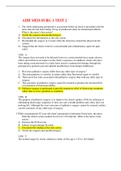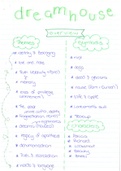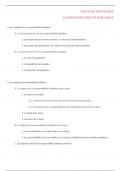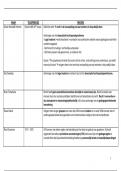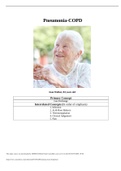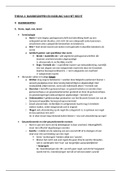Lecture 1 l Personal networks across the life course and an
introduction to ‘wicked problems’
Today:
Introduction to the course
Social networks and the networks society
The convoy model
Generational differences in social networks
Wicked problems: an introduction
INTRODUCTION TO THE COURSE
Setup Networks 1 and 2
Networks track of Social Sciences for Society (SS4S):
Networks 1 (P4) → multidisciplinary theory and analyses
Networks 2 (P5) → interventions
Four themes in Networks 1 within lectures:
Social network as a concept
Social embeddedness
o Emphasis on loneliness (sociology department), but also about integration in
organizations (organization sciences department).
Negative relations
o Social relations are usually framed as a positive thing to have (it is important to have a
lot of friends, to be in social contact with others), but there are also negative aspects
to social relationships, because if the cohesion is to high, it can generate stress.
Power and inequality in networks
o Status attainment, corruption, etc.
Lectures 1 to 4 → Bianca Suanet (1&2) and Christine Moser (3&4):
Lecture 1 l Personal networks across the life course and an introduction to wicked problems
Lecture 2 l A loneliness epidemic? Causes and consequences of loneliness
Lecture 3 l Social networks in organizations: an overview
Lecture 4 l Embeddedness in organizational networks: knowledge and collaboration
Lectures 5 to 8 → Bianca Suanet (5&6) and Christine Moser (7&8)
Lecture 5 l Friend or Foe? The good and the bad in social relationships
Lecture 6 l The Matthew effect: social capital and status attainment in (post)modern societies
Lecture 7 l Negative ties: the good, the bad, the ugly
Lecture 8 l Power and social capital
Lectures 9 and 10 → Yarin Eski (9&10):
Lecture 9 l The Port of Rotterdam, drugs and corrupted dockers: networks and motivations
Lecture 10 l The Port of Rotterdam, security and multi-agency policing: cooperation and
rivalry
Lectures 11 and 12 → Two guest lectures (Political Sciences / Public Administration):
Lecture 11 l Networks, surveillance and the power of Big Data (Anneroos van Hardeveld, VU)
Lecture 12 l Networks and climate: environmental governance and networks (Oscar
Widerberg, IVM)
Workgroups → working on a paper on loneliness in multidisciplinary teams of students and studying
the research question on loneliness from different disciplines.
,There are three workgroups (in week 2, 4 and 6):
Workgroup 1 l Meeting of students and creating a research question based on literature on
loneliness read by students.
Workgroup 2 l Create mind gap of answers to research question chosen by the group and
make an outline and division of labour for the writing process.
Workgroup 3 l Present the paper to the group and the teachers for feedback.
SOCIAL NETWORKS AND THE NETWORK SOCIETY
Network Society → Van Dijk:
Definition network society:
‘A modern type of society with an infrastructure of social and media networks that
characterizes its mode of organization at every level: individual, group/organizational and
societal…’
‘... we live in a connected world and (...) society is ever more connected (...) it is becoming a
network society’
‘In Western societies, the individual linked by networks is becoming the basic unit of the
network society’
The idea is: we live in a connected world, and we are more connected than ever (that is often what we
hear):
In earlier days, people would often come together as a community: neighbourhoods were very
cohesive, people would all know each other.
People now tend to have networks that are more disperse across various neighborhoods, they
are in their own city, but are not tied to their neighborhoods anymore.
The individual link by networks seems to be becoming the basic unit of our society.
Van Dijk (main ideas):
Digital communication starts to take a more important role in how we talk to each other.
These media networks replace or complement the face-to-face communication that we have
now → a society that increasingly organizes its relationships in media networks that gradually
replace or complement the face-to-face communication based networks.
Contrast this network society to the mass society that is shaped by groups, communities, and
organizations that physically organized.
Network Society → Castells:
He also believes that the importance of digital communication will go up (just like van Dijk
does), but he goes one step further → he thinks that if you look at digital communication and
networks, they will be the new basic units of society: ‘communications technologies allow
for the annihilation of the space and globalization; and changes the relationship to time
(‘space of flows’).
He discusses this in his ideas of the ‘space of flows’ → the new communication technologies
that we have make sure that the time and space that we have with other people that we
communicate with at far distances, becomes annihilated (it disappears).
If you send someone a email, almost immediately you can pop up the email, that he
means with the annihilation of space → you are able to communicate with people
across large distances.
The ability to participate in the network is determined by the degree to which the node can
contribute to goals of the network → if you want to solve a problem, a person/actor is only
able to solve the problem if he is connected to others in the network.
Consequences for social policy? In the earlier days: if you had a government that had a top-
down system, it would be easy to solve the problem, but right now it is more important,
because actors can affect the outcome for others.
Networks are not a new development:
Networks are not a new mode of social organization: they have been around for a long time, and we
have studied them for quite some time in many social sciences, including sociology.
,One important distinction in the study of networks → the distinction between ego-centered
networks versus complete networks:
Ego-centered network → you have the ego itself (one individual), which is considered the
vocal point within the network, and there are several people (like a, b, c, d) that are all
connected to the same individual: in a ego-centered network you look at the network from an
individual perspective.
o Ego-centered networks: networks (of a specific type) from the perspective of a single
actor (ego)
Complete network → if you are able to study not only the people who relate to one individual,
but that you can also study the ties between all units within the social network: in a complete
network study you not only know that you are related to your friend, but you also know
whether your friend is related to all of your other friends → complete network about how the
whole network looks like.
o Complete (or full) networks: the relations (of a specific type) between all units of a
social system are analyzed.
Social relations as a subject of study:
Relevance of studying social relations has not always been as widely recognized as it is
today.
Social relations often had a lack of credibility as a science: they could not be measured
objectively.
And they were presumed to have no effect on objective outcomes.
It did have a lot of impact on (mental) health, it started to increase.
But why study social relations?
Social relations are important for well-being and health
Social relationships determine access to social support and care.
Social relations and social support can buffer stress (but can also generate it → lecture 3)
Social relationships know different manifestations in different contexts.
In sociology, the idea is that the modernization of society (industrialization, etc.) made people move to
the cities, made people do different types of labour (from physical labour to being at your desk) and at
the same time the question was: if there are processes of individualization and modernization, it is true
that communities will survive or not? → this is one of the questions that sociologist have been trying to
answer, and did not find a single answer to, but more that there are different answers to that.
On the one hand: you could say that because of modernization some communities have
declined.
But one the other hand: some communities have been saved (a lot of associations) still play a
very important part in our society.
Some communities have been saved, the society has changed a lot.
THE CONVOY MODEL (EGO-CENTERED NETWORK)
The importance of the Convoy Model is understanding how emotionally close people are to others,
and it has a life-course perspective (it takes a viewpoint of looking into your entire life and to see which
people come in and out of the network over time) → emphasis on emotional closeness in
relationships and life span psychology.
‘The social convoy provides a protective base and is part of a dynamic network that moves
through time, space and the life course.’
‘Takes a life course perspective: the convoy changes as the need and opportunities to give
and receive support changes.’
Convoy model → peoples social relationships from a life course perspective → social relations
have multiple dimensions:
1. Structure: size, composition, contact frequency
2. Function: social support, care, affect
3. Quality: positive and negative
, It is not only the individual matters, but it also the context in which you live that matters for the network
that you have.
The Convoy model → advancements:
1. Social relations are multidimensional (structure, type, function and quality)
2. Identifying how personal characteristics have an impact on social relations.
3. Social relations can be measured objectively or subjectively → loneliness is not necessarily
100% measured by the amount of ties that you have: you could have a lot of ties, but still feel
lonely.
4. Social relationships are considered important at any given time, yet they also build from
previous experience and become more significant over time.
5. Circumstances and context are important for social relationships; for structure, function and
quality.
Network identification in the Convoy model:
How do we measure social relationships in the convoy model? → you need to place people in three
circles around you: ‘network identification on the basis of emotional closeness’ → place people within
three circles around you:
Close
Closer
Closest persons that you cannot imagine living without
From variable to pattern-centered:
Grouping of individuals based on their social relationship characteristics → rise of the so-called
‘network types’ as variables:
Restricted networks: little social relationships, low contact frequencies → people who are the
most at risk of social isolation and loneliness
Family-focused networks: in lower socioeconomic status groups
Friend-focused networks
Diverse networks → the best protection against social isolation and loneliness
Other advancements:
Inclusion of multiple perspectives on support exchange
Longitudinal data: changes across the life course
Generational differences: how societal changes shape social networks across historical time
Implications for social policy: extent of support that is available can be gauged from the
convoy
Relation to well-being: if you have a certain network structure, this has implications for
well-being and loneliness.
GENERATIONAL DIFFERENCES IN
SOCIAL NETWORKS
Individualization:
Process in which individuals have acquired more autonomy and freedom of choice (Beck &
Beck-Gernsheim, 2002)
Decline of traditional communities such as churches, extended families and neighborhoods.
o Individual rights become more important, whereas traditional norms and customs
become less important.
o (Greater) freedom in writing one’s autobiography.
o Thus, less protection, but also more freedom in how we want to build our network etc.
Individualization → more to choose (economic growth), more freedom of choice (secularization), and
better equipped (tertiary education)?
Video paradox of choice → individualization and social networks:



